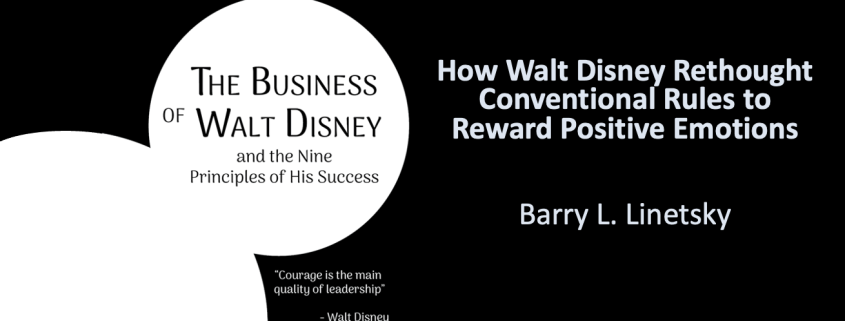How Walt Disney Rethought Conventional Rules to Reward Positive Emotions
© Barry L. Linetsky, 2025. All Rights Reserved.
In my book The Business of Walt Disney and the Nine Principles of His Success (2017; Updated Edition, 2023: 492-494), I identify as one of Walt’s success principles his commitment to “Create Valued Experiences Through Business Design and Innovation.” What follows is an excerpt demonstrating why and how Walt applied this principle.
Read more: How Walt Disney Rethought Conventional Rules to Reward Positive EmotionsPrior to Disneyland, there was an established paradigm for designing an amusement park. As a general rule, parks were set out in a grid, allowing maximum access from four directions. They were built to attract attention, so creating maximum visibility was important. In thinking about Disneyland and how to improve the experience for visitors, Walt had to rethink the conventional rules. The existing established conventions produced results he abhorred. Following current conventions would have led Walt to the same unsatisfactory results.
Walt was an optimist and operated with beliefs and values that provided him with a genuinely benevolent sense of life—a conviction that the world is open and receptive to human efforts to remove barriers and reward actions that result in the improvement of our well-being. He believed that the vast majority of people are good, fair, and honest, and held the same common-sense life-affirming values that he did. When people were disappointed the most, it was because their expectations failed to be met due to a lack of imagination, creativity, and mental effort on the part of product and service providers. Too many business proprietors took their customers for granted, or worse, held them in contempt and treated them in an unfair, unjust, disrespectful, and sometimes demeaning manner.
From Walt’s perspective, the first place to look when people are behaving badly is the environment in which they find themselves. By identifying and creating trust-inducing environments, he hoped to facilitate and encourage positive behavior. He believed that if you demonstrate respect for people by building environments that were respectful of people, they would reciprocate that respect with appropriate benevolent behavior that was good for business.
The conventional view amongst amusement park industry operators was to assume people were seeking opportunities to act out anti-socially in ways harmful to the proprietors and others, and therefore any show of respect toward customers would be wasted. Recall the advice of the leading park owners to Walt: don’t provide customized rides because the public won’t know the difference, they don’t care, and worse, they will vandalize them no matter what you do; and don’t bother with things like the castle and a horse-pulled trolley on Main Street or the fancy landscaping and authenticity of design because they don’t generate any income and the customers won’t really notice, so there is no reason to build and maintain them.
The prevailing wisdom of showing disrespect to customers, and people in general, was built right into the amusement park industry business model, and so no attempt was made by park owners and managers to strive for improvements. Instead, customer disrespect became a cynical excuse to exploit the “local yokels” and tourists who come to fairgrounds to satisfy their primal urge for sensual stimulation, danger, and an adrenaline rush. The challenge for the amusement park owner and carny was to separate as much money from the “marks” by any means and as quickly as possible. Designing a better environment was seen as harmful to their “proven” business model and thus a waste of time and effort.
Walt was convinced that he could use design principles and psychology to overturn convention and appeal directly to the best in people, and by doing so create a uniquely positive entertainment experience that families would find emotionally rewarding and for which they would be happy to pay more. Seen this way, Disneyland was just another extension of Walt’s artistic dedication to lifting the human spirit and the human potential.
Another way in which Walt rethought conventional rules was to apply what he had learned in his study of modern urban planning techniques to produce healthier human environments. To create the relaxing and refreshing guest experience he envisioned, Walt sought to design a park where the maximum number of operational and maintenance elements experienced by guests could be controlled, hidden, or eliminated altogether. Walt worked backwards during the planning stage to develop innovative design solutions that would maintain the purity of the show.
One of the ingenious, paradigm-shifting solutions incorporated in Orlando was to build the park on the second floor of a two-story structure, thereby using design innovation to achieve a more unique and fully immersed guest experience. By building the park this way, writes Nate Naversen,
Disney can quickly whisk supplies in and out of the park from below without having to bring a truck through the front gates. In medical emergencies, heart attack victims may be quickly taken off stage to a medical facility without disturbing most guests. … Trash may be placed in an underground vacuum network at dozens of locations around the park, where it may be quickly vacuumed to a central receiving area, saving time and energy for custodial people. Lastly, cast members in costume can walk straight into their themed land without having to walk through another land.
Walt’s design innovations such as underground utility corridors, vacuum garbage disposal technology, and unique custom attractions and transportation systems added significant upfront capital investment for infrastructure. In return Walt was able to create an unprecedented positive guest experience that was critical to winning the endorsement of the public and justifying the investment and long-term payback.
© 2025, Barry L. Linetsky. All rights reserved.
Barry Linetsky is the author of the acclaimed and best-selling book The Business of Walt Disney and the Nine Principles of His Success. He is a senior-level strategic advisor and enabler, writer, researcher, and photographer. His thought-leadership and research has been published by Rotman Magazine and Ivey Business Journal [https://iveybusinessjournal.com/?s=linetsky]. He blogs on strategic business issues at www.barrylinetsky.com. His current interests pertain to the application of new knowledge and skills to master value-creation under current and emerging conditions of increasing socio-technical complexity.

 © 2024 Barry L. Linetsky. All Rights Reserved
© 2024 Barry L. Linetsky. All Rights Reserved
 © 2019, Barry L. Linetsky. All Rights Reserved.
© 2019, Barry L. Linetsky. All Rights Reserved.
 © 2020, Barry L. Linetsky. All Rights Reserved
© 2020, Barry L. Linetsky. All Rights Reserved
 © 2024 Barry L. Linetsky. All Rights Reserved.
© 2024 Barry L. Linetsky. All Rights Reserved.
 © 2022 Barry L. Linetsky, All Rights Reserved
© 2022 Barry L. Linetsky, All Rights Reserved © 2024, Barry Linetsky, All Rights Reserved
© 2024, Barry Linetsky, All Rights Reserved Barry L. Linetsky, 2024. All Rights Reserved
Barry L. Linetsky, 2024. All Rights Reserved
Leave a Reply
Want to join the discussion?Feel free to contribute!